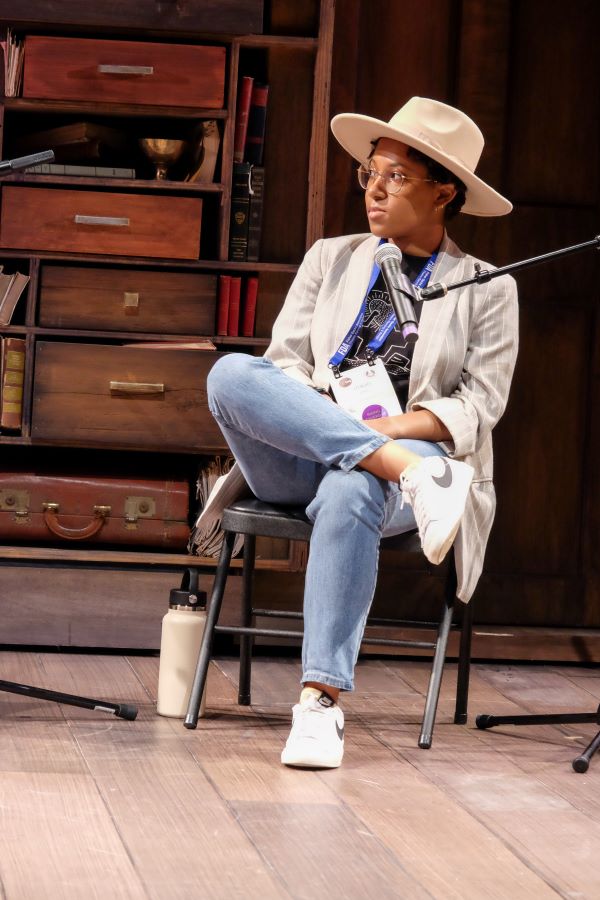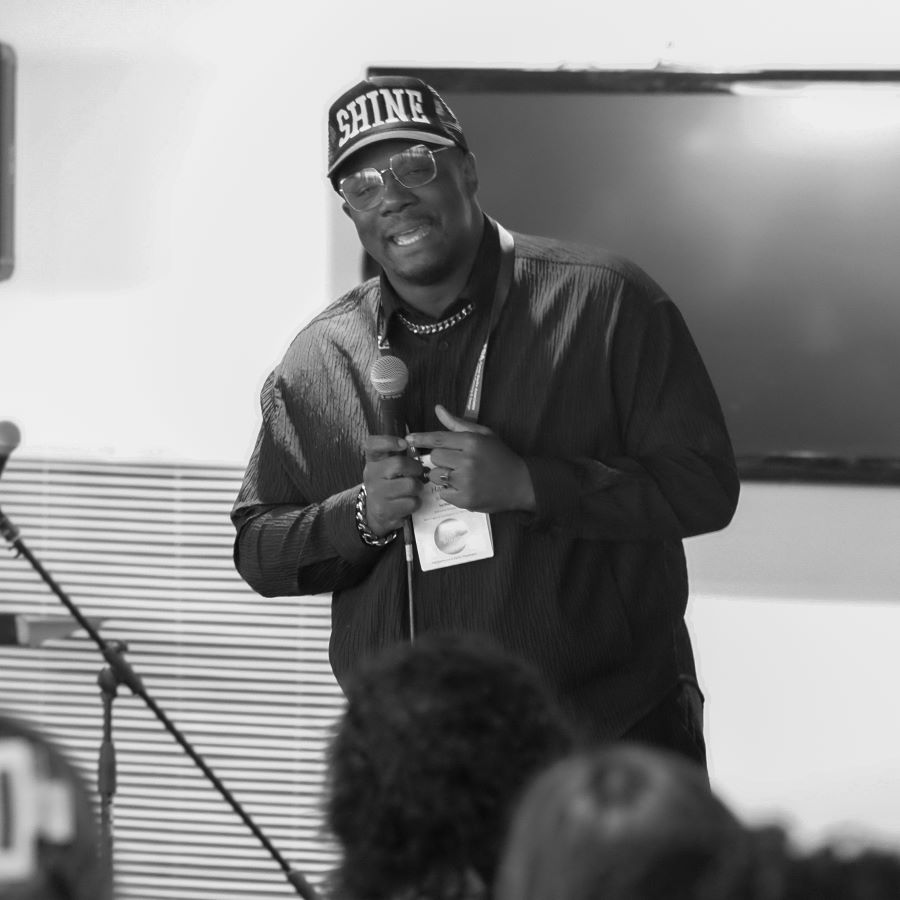It felt serendipitous that this year’s Theatre Communications Group national conference occurred the same week as Octavia Butler’s birthday (June 22). From the moment I came off the plane I felt in my gut that some kind of change was manifesting itself, soon to be revealed at this conference.
Would it be a new connection?
Would it be a new insight?
Would it be something unexpected and profound?
Whatever it would be, in a city that carries a history of activism and changemaking, I welcomed it with open arms.

On the first day of the conference, I met with current and former Rising Leaders of Color, joyously meeting for the first time and learning about our shared histories, beliefs, and overwhelm through introductions and creative exercises throughout the hour we had together. By the end of our time, we became each others’ people, and I had a growing sense as to why I was here, only to be fully fleshed out later that afternoon.
At the opening plenary at Chicago Shakespeare Theatre, the provocations had me riled up. After spending the day making new friends and connections, and exploring away from the main conference space, I was ready to hear what was rising “From the Ashes.” This set of provocations were in conversation with Jesse Cameron Alick’s 2021 study, commissioned by the Sundance Institute, “Emerging from the Cave: Reimagining Our Future in Theater and Live Performance”, which highlighted what artists and arts workers were going through early on in the pandemic and throughout its calls for equity across the industry. Three years later, Alick’s findings still felt relevant as we face challenges around labor and pay equity, sustaining new-work development, and creating innovative models of leadership and institutional infrastructure.
As an artist whose career didn’t really start until the pandemic, I felt each provocation ring with timeless conviction, calling for change in this revelatory moment. Appeals ranged from uplifting Indigenous and Native voices and stories to responding to crises with dramaturgical context, and closing the financial gaps artists fall through, rendering them unable to sustain careers in the field. Some addressed what it truly means to navigate theatre “post”-pandemic (while not ignoring that it is still happening) and the importance of supporting leaders of color who have inherited institutions that were or still are predominantly white (with internal systems that have yet to change). And Transformations founder and executive director Merrique Jenson, announcing TCG’s Funds for the Dolls, discussed the realities of what trans women of color endure in order to survive.
All served as alarming responses to a call that has rippled and seeped itself into the modern-day current.
As much as I was stimulated by each provocation, I couldn’t help but wonder in that moment, as we name these things, how are we holding each other accountable in a time that demands these things from us and our respective institutions? Holding onto this question, I made my way out of the theatre to attend the Intergenerational Leaders of Color session. Maybe it was here that I could get some personal insight.

In a lobby/balcony that was less than half the size of the theatre we all just came from, we made the space ours and made it feel like a neighborhood. We got to know the many faces who would also become our people for the weekend and beyond, and of course, met the elders and pioneers creating the path forward. With the session led by TCG’s director of grantmaking programs Emilya Cachapero and board chair Harold Steward, we dove right into conversation and connected with one another over prompts related to our hopes for our time at the conference and the challenges we face as global-majority artists in our institutions and field at large. While I wished we could have stayed longer, our time came to a close with a song that I walked away humming to myself: We are the future we have been waiting for.
This mantra showed itself in sessions the following day like “Finding the Yes,” presented by Theater Mu, exploring that there is possibility and growth in the face of uncertainty when led by value and mission. In the THRIVE! Gathering Space for theatres of color, we named and acknowledged the interwoven histories of pioneering and present-day theatres and global-majority artists, discussed BITOC initiatives and conferences, and held space to envision where we see ourselves next.
In naming our arts lineage, recognizing the times when our arts ancestors moved us closer to where we are now—collectively and in shared space—the hummed mantra became more than a phrase to repeat. It became a prophetic statement. In these exercises, I felt the weight of the significance, and the internal friction, of how to honor these lineages without putting them on a pedestal.
By the end of the day, I continued to piece together the lessons and insights of Friday’s sessions, reflecting on my own journey and gearing up to share it with audiences and peers on Saturday’s panel “From Critique to Collaboration: Journalist-Artists Commune for Theatre’s Evolution,” in which I served as a panelist alongside Regina Victor, Amanda L. Andrei, and Gabriela Furtado Coutinho. (The moderator was Adrienne Brown.) Though I was nervous, it was joyously grounding to be in conversation with these fellow artist-journalists, all of us navigating the generational shifts in arts journalism and cultural criticism, the gray space of being multi-hyphenate artists, and the questions of nurturing the next generation of arts journalists.
As empowered as I felt toward the end of the conference, the closing plenary reminded me that, while we can come together collectively, we still have a ways to go. The closing panel uplifted the impact of Lorraine Hansberry as both an activist and a playwright, but it also highlighted the multifaceted complexity and dire need for intergenerational dialogue in our field—as well as the need to welcome conflict in creating transformation.
In the weeks since the conference, we have faced the Chevron Deference ruling, the ban on homelessness, and other pressing decisions made by our nation’s Supreme Court. The question remains at large: What is the responsibility that theatre institutions and theatremakers have to the people? And, again: How are we holding each other accountable in a time that demands these things from us and our respective institutions?
Butler, our ancestor, was able to envision the challenges and growing concerns 30 years before they happened and contrarily predicted the future in her works The Parable of the Sower and The Parable of the Talents, all just by looking around and observing the conditions of the world in which she wrote these books. As I meditate on what is occurring in the United States and abroad, and the impact change has made across all facets, my revelation is that we have reached a place where we must engage in action. No longer can we be frozen by the thought of change, waiting for the right moment, if indeed we are the future we have been waiting for.
As we look at the challenges we will have to face, I think of Butler’s words from A Few Rules For Predicting The Future: “There’s no single answer that will solve all of our future problems. There’s no magic bullet. Instead there are thousands of answers—at least. You can be one of them if you choose to be.”
afrikah selah (they/them) is a Boston-based multihyphenate cultural worker specializing in producorial dramaturgy, new-play development, and arts journalism.


